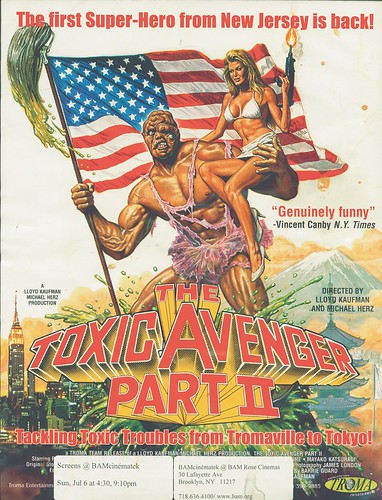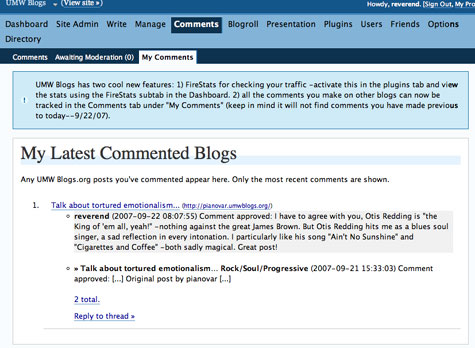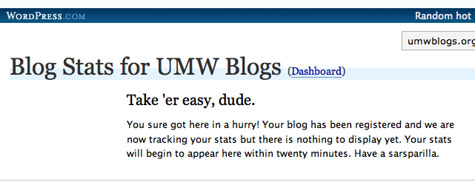Well, I am finally decompressing from the Open Education 2007 conference, and its been an interesting three days. Among the numerous highlights was re-connecting (in person) with D’Arcy, Scott, and Brian, as well as meeting folks I have followed through the tubes like David Wiley. Not to mention all the new folks I have met, to name just a few Jen, Pedro, Kim Tucker, and Keri (who from what I understand was under the impression I was a bonafide Reverend -well aren’t I?). Cool people make all the difference, and there were more than a few at this conference.
That said, there was a general feel at the conference that might be likened to an uncertainty about the future of open content in relationship to issues of scalability, sustainability, localization, and other infra-structural issues that often compel those who have something to lose into the realm of trying to predict and control outcomes rather than imagining possibilities. The more I think about it, the more I think that content is not something that can be imagined outside of a cultural or community context, it is something that has to be conceptualized within a very specific space. During my talk with D’Arcy I started to imagine the University of Mary Washington as a college with very few resources as compared to the wealthier institutions such as MIT, Berkeley, Yale, and many of the other prominent US institutions present at this conference, not to mention all the representatives from large international institutions.
In fact, I found myself saying to folks repeatedly when they asked me “Mary What? Where are you from again?” “Oh, I’m from a small public school in Virginia.” In many ways I started to think about the visions of development and the questions of scale as a frame for how institutions with so many resources can begin to divine how to frame out a series of open resources to tackle the uneven development of nations, while not even beginning to think about the uneven development of educational resources in any given state of the US. This is by no means a knock on any of these institutions, but rather a call to action. The University of Mary Washington is preparing for some lean years to come and we are by no means a rich school to begin with. The faculty and staff are paid decidedly less than most other schools in the state and we have avoided larger enterprise LMS systems and other “sustainable and scalable solutions” as much because of a lack of resources as a lack of interest.
What might some of these larger institutions learn from a school like UMW with a particular community that has a specific set of challenges, concerns, and scarcity of resources? Well, for one, they can think about how creating large, over-arching systems to manage open content is most likely a colossal waste of time, energy, and money. Of the examples I saw at the conference, I wasn’t overly impressed by any one thriving community surrounding the re-purposing or sharing of open content. In fact, I would suggest that creating content repositories is probably not the answer to the problems of scarcity, access, and openness, and this is a sentiment many seemed to echo throughout the three days. But why, then, were so many of the discussions premised around issues of scalability, sustainability, and infrastructure?
Content is being created on the open web daily. Why force-feed “developing” nations another series of systems when we should be working on allowing them to either access or easily create the resources that are already out there. For example, a small and relatively poor school like Mary Washington has in the last three weeks spent all of $30 (monthly mind you) to create an active blog archive of resources about a wide variety of subjects like British Literature, Video Art, Women & Western Art, Islamic Literature, Asian Literature, Creative Writing, Cell Biology, Instructional Design, Banned Art, and the list goes on, for its specific community of 3500 learners. We haven’t been doing this for more than three weeks but have over 4,000 posts that are out there on the open web, all of which have the potential to be searched, found, and used by other folks for their own education (formal or otherwise).
Moreover, we are using an open source tool (WordPress Multi-User) that costs nothing, is simple to set up, and has a phenomenal community of users that are constantly fine tuning both the code base and extending the functionality of the system. $30 bucks a month! I fully recognize that the work I have been doing over the last year is in effect making my actual position in some ways redundant, and I think that is important. What could be better in this field if you can find a tool (although its not all the tool-granted) that helps build learning communities that is so cheap, easy to manage, and awesome that it could pretty much run itself? Allowing the user to have full proficiency to publish their thoughts and ideas to the web without any obstacles. That, for me, is the pinnacle of success because it works against all the ludicrous notions of having to keep yourself relevant and useful. That is the problem with institutional thinking on all of these issues, they want to keep themselves relevant in regards to issues of sustainability, scalability, and cost recovery, when it has become readily apparent that they are increasingly irrelevant in regards to infrastructure in the age of the open read/write web with search engines like google and tools like Blogger, Wikipedia, WordPress.com, Drupal, MediaWiki, and the list goes on.
Focus on creating a great space for teaching and learning at your institutions that is dynamic, forward thinking, and multi-modal, while at the same time capturing it in some digital form (or at least its trace) and make it freely available on the web. Why are we creating new tools? Why are we trying to design course modules with new content? D’Arcy articulated some pretty profound musings at the conference that I was lucky enough to overhear: “let’s put a moratorium on developing new tools” as well as “a moratorium on developing new content.”
Yes! Use the tools that currently work to populate the web with existing resources. Then work on ways to manage the flow of data, to quote Brian again and again, at institutions and get out of the business of providing nuts to bolts infra-structure. This is not only a solution for institutions and educational interests more broadly, but also an extremely cheap and reasonable means for “developing” nations to frame out their own distributed learning networks. Why are we re-inventing the wheel? Let’s just put it all out there and find ways to get it to folks as easily as possible, rather than wasting so much money on re-thinking the wheel? Small communities throughout the world will create resources relevant to them, no matter where they are located, and that relevance will make them that much easier to find on the open web.
Can rich institutions of the West build relevance for the rest of the world? Perhaps, but I don’t think they can do it very effectively or efficiently. And if we do, it’s no longer called relevance, its more akin to cultural imperialism. We need simple, affordable micro-cultures for teaching and learning, not macro-cultures for delivery and consumption.


 2. Mystery is a basic element of all works of art. It is generally lacking on the screen. Writers, directors and producers take good care in avoiding anything that may upset us. They keep the marvelous window on the liberating world of poetry shut. They prefer stories which seem to continue our ordinary lives, which repeat for the umpteenth time the same drama, which help us forget the hard hours of our daily work. And all this, of course, carefully watched over by traditional morals, government and international censorship, religion, good taste, white humour and other flat dicteria of reality.
2. Mystery is a basic element of all works of art. It is generally lacking on the screen. Writers, directors and producers take good care in avoiding anything that may upset us. They keep the marvelous window on the liberating world of poetry shut. They prefer stories which seem to continue our ordinary lives, which repeat for the umpteenth time the same drama, which help us forget the hard hours of our daily work. And all this, of course, carefully watched over by traditional morals, government and international censorship, religion, good taste, white humour and other flat dicteria of reality.
 I can’t begin to tell you how deeply I respect the intellectual generosity of
I can’t begin to tell you how deeply I respect the intellectual generosity of 



